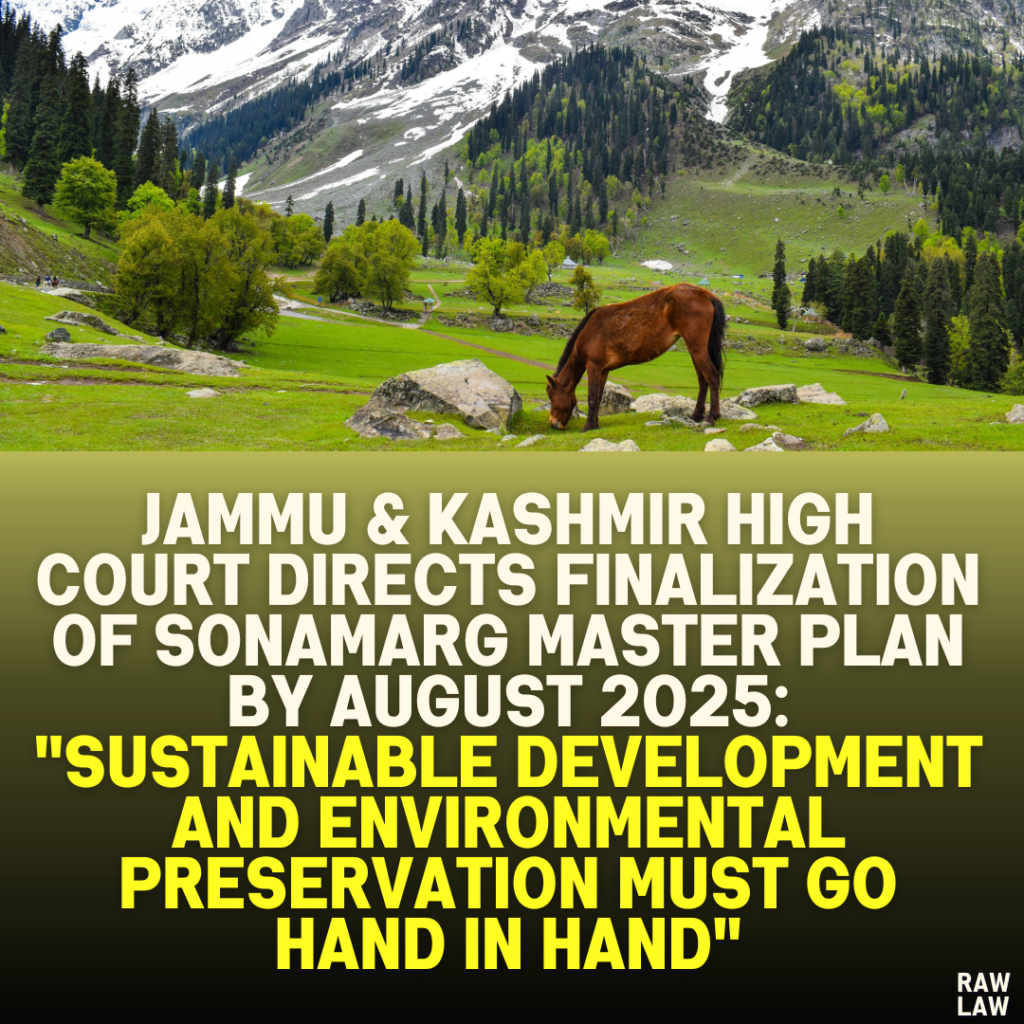Court’s Decision:
The High Court of Jammu & Kashmir and Ladakh disposed of the Public Interest Litigation (PIL) filed in 2011, directing:
- Finalization of the Master Plan 2025-2045 by August 2025 to address environmental degradation in Sonamarg and ensure sustainable development.
- Strict implementation of Solid Waste Management Bye-Laws.
- Removal of illegal constructions in and around River Sindh as per the law.
- Installation of solid waste treatment plants by commercial establishments to manage non-biodegradable waste effectively.
- Oversight and compliance of all construction activities by the Building Operations Controlling Authority (BOCA) under the applicable laws and prior court orders.
Facts:
- The PIL was initiated in 2011 by a practicing lawyer who highlighted severe pollution in River Sindh, caused by unauthorized constructions, hotels, and tourist establishments.
- The petitioner emphasized that these activities violated environmental laws and posed significant threats to the river’s ecosystem, urging immediate corrective measures.
- The court initially issued interim orders to halt unauthorized construction in Sonamarg and its surroundings, appointing commissioners to report on the ground realities.
- Although the petition was disposed of in 2015, reports of unchecked illegal activities led to its revival in 2017. Subsequently, the petition’s scope was expanded to cover broader issues, including:
- Pollution in Sonamarg.
- Degradation of Thajiwas Glacier and Wildlife Sanctuary.
- Management of vehicular traffic, pony tracks, and solid waste.
However, in 2021, the court refocused the petition on its original intent—preventing pollution in River Sindh and removing illegal constructions.
Issues:
- Whether the authorities failed to prevent pollution in River Sindh caused by unregulated activities and constructions.
- Whether the current Master Plan for Sonamarg adequately addresses environmental concerns and sustainable development.
Petitioner’s Arguments:
- The petitioner argued that unchecked construction and pollution violated environmental laws and ignored the fragile ecology of River Sindh and Sonamarg.
- Highlighted negligence by authorities in regulating activities along the riverbanks, contributing to pollution and encroachments.
Respondent’s Arguments:
- Respondents claimed efforts were underway to regulate construction activities and formulate a revised Master Plan for Sonamarg (2025-2045), incorporating sustainable practices.
- They argued compliance with previous court directions, including actions to mitigate pollution and enforce construction regulations.
Analysis of the Law:
- Environmental Protection Laws:
- The court stressed strict adherence to the Solid Waste Management Rules, 2016, emphasizing the necessity of proper waste segregation, disposal, and treatment.
- It reiterated the Jammu and Kashmir Water Resources (Regulation and Management) Act, 2010, underlining the responsibility of authorities to regulate pollution and protect water bodies.
- Sustainable Development Principle:
- The court emphasized balancing economic development with environmental conservation, advocating the preservation of natural resources and landscapes.
- Highlighted the polluter pays principle to hold violators accountable for ecological damage.
Precedent Analysis:
- The court referred to prior judgments and orders emphasizing environmental preservation and sustainable planning.
- Earlier rulings on solid waste management, unauthorized construction, and river pollution informed the court’s directives in the present case.
Court’s Reasoning:
- The court criticized authorities for their delay in finalizing the Master Plan 2025-2045, observing that the Master Plan 2005-2025 was nearing expiry without substantial revisions.
- It acknowledged the necessity of public involvement in drafting the Master Plan, ensuring that all stakeholders’ concerns are addressed comprehensively.
- It noted the failure of authorities to prevent encroachments and enforce pollution regulations, which had exacerbated ecological degradation.
- The court expressed concern about ongoing threats to the Thajiwas Glacier, Sonamarg Wildlife Sanctuary, and River Sindh, calling for immediate measures to safeguard these natural resources.
Conclusion:
The court disposed of the PIL with detailed directions:
- Master Plan Finalization:
- The revised Master Plan for Sonamarg (2025-2045) must be finalized by August 2025. It should address sustainable tourism, solid waste management, and ecological preservation while considering prior court directives and suggestions from the Amicus Curiae.
- Construction Regulation:
- All construction and renovation activities must comply with statutory requirements and court orders, ensuring no further ecological harm.
- Illegal constructions must be removed in accordance with the law.
- Solid Waste Management:
- Commercial establishments must install waste treatment systems.
- Authorities must enforce the Solid Waste Management Bye-Laws.
- Monitoring and Compliance:
- The court emphasized regular monitoring of construction and pollution activities by relevant authorities to prevent violations.
The court appreciated the efforts of the Amicus Curiae for assisting in the case and ensuring comprehensive suggestions were provided.
Implications:
- Environmental Impact:
- The judgment is a critical step toward restoring River Sindh and Sonamarg’s ecological balance, ensuring the preservation of these natural resources for future generations.
- Sustainable Tourism:
- By emphasizing sustainable practices, the directives aim to make Sonamarg a model for eco-friendly tourism in the region.
- Accountability:
- The judgment reinforces the responsibility of authorities to regulate construction and pollution, holding them accountable for lapses.
- Judicial Oversight:
- This case highlights the role of the judiciary in enforcing environmental laws and advocating sustainable development.




Pingback: Delhi High Court Dismisses Review Petition Challenging DDA’s Allotment Decision, Rules Voluntary Cancellation, Delay, and Laches Bar Legal Claims Despite Clerical Errors - Raw Law